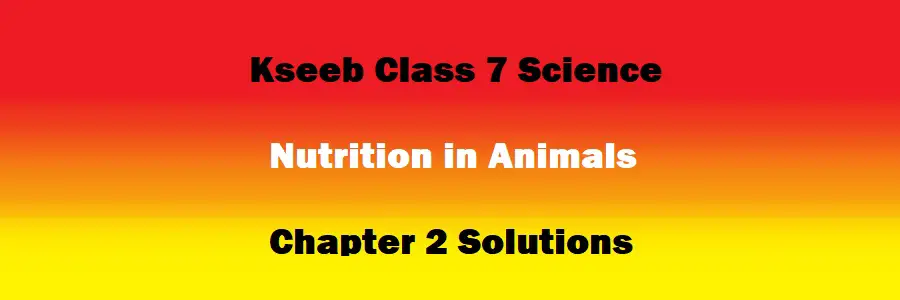Kseeb Class 7 Science Chapter 2 Nutrition in Animals Solutions
Welcome to NCTB Solutions. Here with this post we are going to help 7th class students by providing KSEEB Class 7 Science chapter 2 Solutions, Nutrition in Animals. Here students can easily find all the answers for Nutrition in Animals chapter. Also here our Expert Science Teacher’s solved all the exercise questions with easily understandable language with proper guidance so that all the students can understand easily. Here in this post students will get chapter 2 solutions. Here all the solutions are based on Karnataka State Board latest syllabus.

Nutrition in Animals Exercise Solutions :
(1) Fill in the blanks :
(a) The main steps of nutrition in humans are ___,___,___,___ and ___
(b) The largest gland in the human body is ___
(c) The stomach releases hydrochloric acid and ___ juices which act on food.
(d) The inner wall of the small intestine has many finger-like outgrowths called ___
(e) Amoeba digests its food in the ___
Answer :
(a) → Ingestion, digestion, absorption, assimilation and egestion
(b) → Liver
(c) → Digestive juices
(d) → Villi
(e) → Food vacuole
(2) Mark ‘T’ if the statement is true and ‘F’ if it is false:
(a) Digestion of starch starts in the stomach.
(b) The tongue helps in mixing food with saliva.
(c) The gall bladder temporarily stores bile.
(d) The ruminants bring back swallowed grass into their mouth and chew it for some time.
Answer :
(a) → False, Because the digestion of starch begins in mouth while intake food and saliva break down starch in sugar.
(b) → True
(c) → True
(d) → True
(3) Tick mark the correct answer in each of the following:
(a) Fat is completely digested in the
(i) stomach
(ii) mouth
(iii) small intestine
(iv) large intestine
Answer :
Correct answer → (iii) Small intestine.
Fat is completely digested in the Small intestine.
(b) Water from the undigested food is absorbed mainly in the
(i) stomach
(ii) food pipe
(iii) small intestine
(iv) large intestine
Answer :
Correct answer → (iv) large intestine
Water from the undigested food is absorbed mainly in the Large intestine.
(5) What are villi? What is their location and function?
Answer :
Villi are small finger like projection that are located in the inner wall of small intestine that are meant for the absorption of the food we eat and make them flow with the blood stream to the body were it is needed they are made up of cells.
(7) Name the type of carbohydrate that can be digested by ruminants but not by humans. Give the reason also.
Answer :
Cellulose is the carbohydrate that is digested by the ruminants but not by human as the human lack of cellulose enzyme to digest cellulose which was present in human in the appendix but as human don’t use the organ.
(8) Why do we get instant energy from glucose?
Answer :
We eat food that is first breakdown carbohydrates converted then absorbed as glucose in the blood in sugar form and here the glucose is directly in the sugar form which is easy to absorb by blood.
(9) Which part of the digestive canal is involved in:
(i) absorption of food ____
(ii) chewing of food ____
(iii) killing of bacteria ____
(iv) complete digestion of food ____
(v) formation of faeces ____
Answer :
(i) → small intestine
(ii) → buccal cavity
(iii) → stomach
(iv) → small intestine
(v) → large intestine
(10) Write one similarity and one difference between the nutrition in amoeba and human beings.
Similarity : both human and amoeba are heterotrophs because both take the food from other organisms
Difference : the human have digestive system by which the food is absorbed through the buccal cavity and the amoeba does not have the digestive system which intake the food by the pseudopodia. Human gets nutrients digested in different regions and amoeba directly digest.
Next Chapter Solution :